Heading out the door? Read this article on the new Outside+ app available now on iOS devices for members! Download the app.
No matter what you’ve been told in yoga class or seen on Instagram, the transformative experience you’re seeking in your forward bends actually has nothing to do with how the pose looks. The real benefit comes from how the pose feels.
While any forward bend will stretch your back and provide a grounding energy, the secret to getting more out of this type of pose lies not in your flexibility, but in your breath. When you understand how your breath affects your anatomy—most importantly, your spine—you can maximize your stretch and, at the same time, create more ease in the pose. And the more ease you find, the more calm you experience. Better yet, working with your breath can prevent you from overdoing it and causing a strain. Instead, you’ll remain honest in how you’re showing up in your practice.
See also: Safely Care for Your Body as you Practice Forward Bends
How your breath affects your anatomy
The Viniyoga tradition, in which I was trained, offers several essential teachings about the relationship between breath and anatomy.
- Every movement begins with our breath. The breath initiates the movement of the spine, which initiates the movement of the limbs.
- The way we breathe, if fully understood and practiced appropriately, supports both the anatomical and energetic effects of the posture.
- A gentle and progressive engagement of your low belly helps you achieve a full, deliberate exhalation which in turn supports the posture you are practicing.
- A gentle and progressive expansion of your chest and relaxation of the belly helps you achieve a full, deliberate inhalation, which in turn supports the posture you are practicing.
See also: The Science of Breathing
How to use your breath in forward bends
Most of us have learned to exhale into forward bends and inhale to come out of them. This is a solid starting point! However, you can further refine the breath to your advantage. Once you take the emphasis off how a pose looks, you can find ease and let the breath and gravity guide you.
The following techniques will help you to deepen the outward expression of your forward bends, as well as your inner experience.
Move dynamically
As you exhale, gently draw your low belly muscles in and feel how that begins to subtly guide your body into the action of the forward bend. As you inhale, feel first the expansion of your chest and how that naturally begins to guide you out of the posture. As you continue to breathe and move, notice how each exhale naturally contracts and settles your body, and how each inhale naturally extends and expands your body.
If you feel it, even in a very subtle way, you’re definitely getting it! Bending your knees slightly as you move dynamically through a forward bend will also support your breath by creating less restriction in your legs, hips, and back, and allowing your spine to extend, which will promote space for your breath to reach full capacity. Even if you’re very flexible, I highly recommend practicing a few times with slightly bent knees so you can experience the fullness of your breath.
Don’t rush
This is where the real magic happens! The thing I love about holding postures is that they are actually slightly dynamic, due to the nature of our living, breathing, pulsating bodies. Think about it this way: even when we’re holding still, the wave of our breath creates subtle movement. Knowing this will completely change your forward bends. Feel how the engagement of your core as you exhale allows your low back to lengthen and relax, inviting a deeper stretch. Making every breath deliberate while you stay in a forward bend will enhance the posture both structurally and energetically. Every inhale helps you lengthen, every exhale helps you deepen into the pose. The difference between the first and the sixth breath will be apparent. The difference one month or one year from now will be deeply profound.
Pay attention
As you remain in the pose, discern the difference between a stretch and a strain. Focus less on what you think a pose should look like and more on feeling your way into expansion and contraction. You want to feel a stretch, but should never feel pain.
See also: Fine-Tune Your Forward Bends
How to practice forward bends
The following instructions talk you through three common forward bends, although you can apply the same principles to any forward bend, like Wide-Legged Standing Forward Bend, Baddha Konasana (Bound Angle Pose), Janu Sirsasana (Head-to-Knee Pose), or any time you are folding at your hips. Keep in mind that finding less intensity and more length in a forward bend sometimes comes only with time and consistency, as with so many things in life.
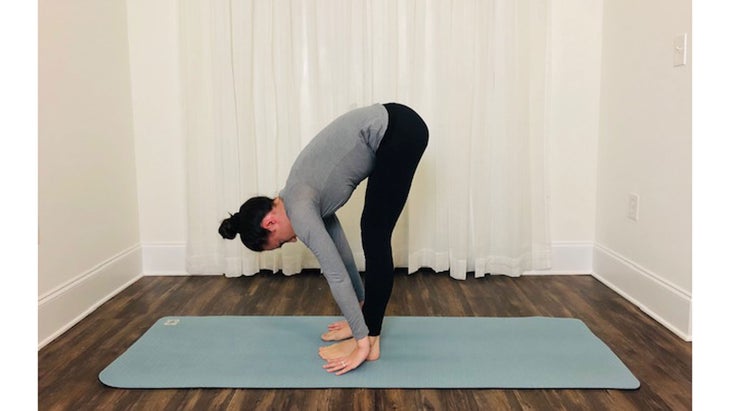
Uttanasana (Standing Forward Bend)
Inhale: From standing, raise your arms overhead and feel the expansion of your chest and the extension of your spine. On an exhalation, gently draw your belly muscles in toward your spine and bend your knees slightly as you bend forward your chest falls more closely to your thighs. On your next inhalation, feel the subtle expansion of your chest and the lengthening in the spine.
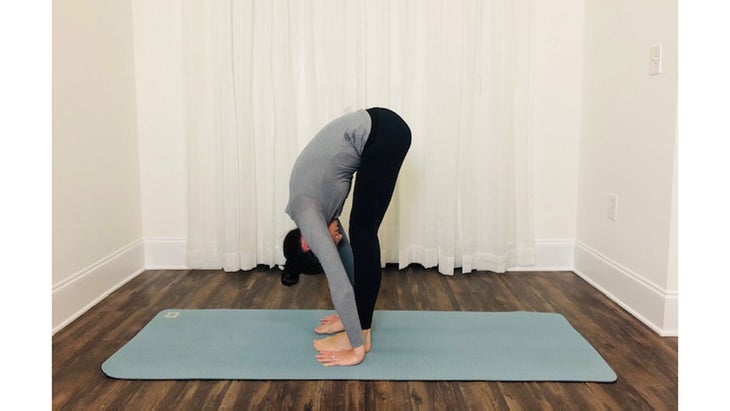
Exhale: Draw your belly in and sink your chest closer toward your thighs, increasing the stretch in your back.
Remain in the forward bend: Repeat with the rhythmic and gentle lengthening and lowering in tune with your breath. If you experience strain in your low back or the backs of your legs, bend your knees more generously and continue using your breathing to remain in and enhance the posture. Do not force the shape of the pose.
See also: 4 Ways to Adapt Standing Forward Bend to Your Body
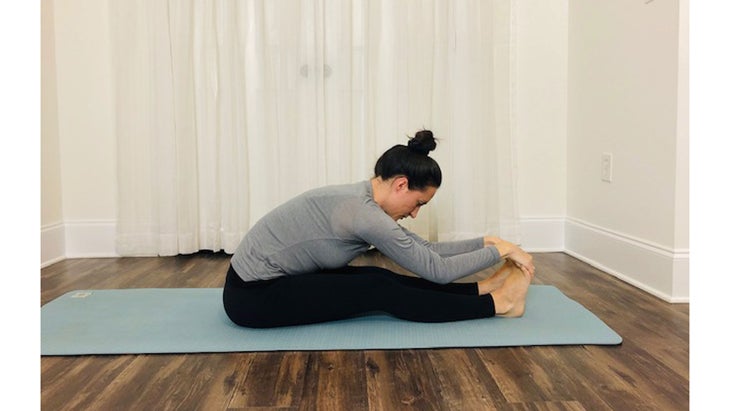
Paschimotanasana (Seated Forward Bend)
Inhale: Sit tall on the mat with your legs straight in front of you, raise your arms alongside your ears and feel the expansion of your chest and the extension of your spine.
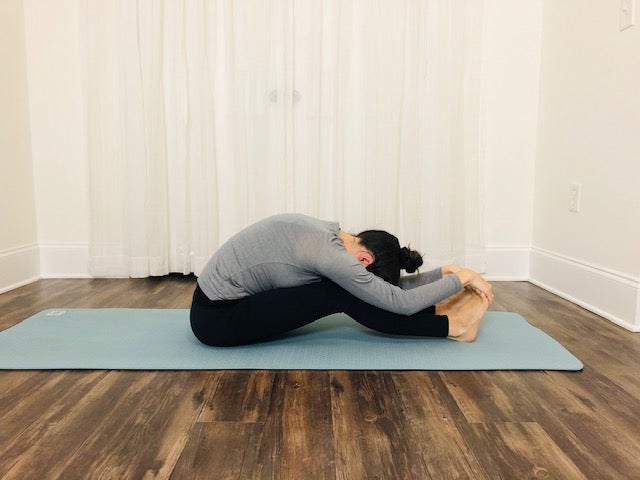
Remain in the forward bend: Use inhalations to reach your chest forward, as if you could slide it closer to your feet, and use exhalations to bring your chest toward your thighs, noticing more stretch in your back. If you experience strain in your low back or the backs of your legs, bend your knees more generously and continue using your breath to enhance the posture. Do not force the shape of the pose.
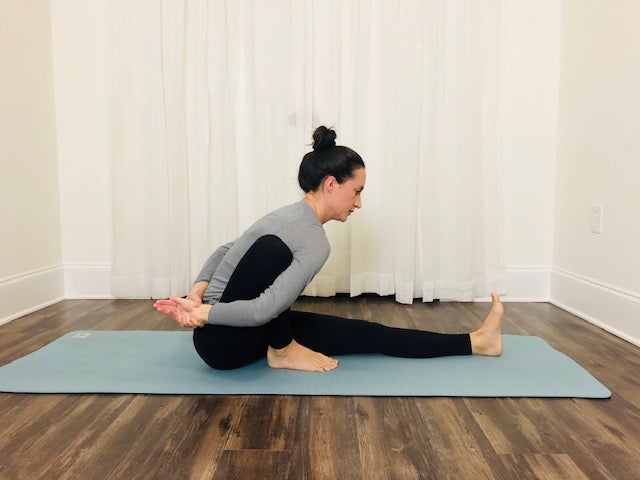
Marichyasana I (Pose Dedicated to the Sage Marichi I
Inhale: Sit on the mat with your legs straight in front of you, bend your right knee to draw your heel in front of your right sitting bone, and let your right knee fall open slightly and tilt your torso forward, so that it comes to the inside of your right thigh. Reach your right hand forward as you lengthen. Draw your right knee back in toward your midline so that your inner right knee hugs your right outer shoulder.
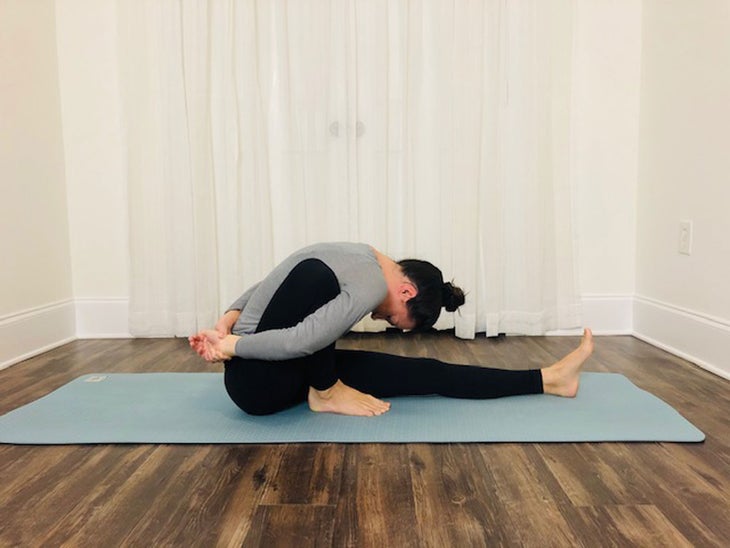
Remain in the forward bend: On an inhalation, lift your chest forward and up, feeling the deep stretch for your upper back and shoulders. On an exhalation, engage your belly muscles in as you bend forward while releasing your shoulders away from your ears. While the bind in the arms can make this posture feel much more restricted, notice how using your breath intentionally can help you enhance the quality of stretch and the grounding energy in this posture.
See also: More Than a Dozen Other Forward Bends
About our contributor
Bernadette Soler is a certified yoga therapist and teacher in the Viniyoga lineage. She is dedicated to the study and practice of yoga and has a gift for applying ancient techniques to our contemporary lifestyles. Bernadette has more than a decade of experience teaching and believes in the life-changing power of a daily yoga practice to uncover one’s potential. She has immense gratitude to her teacher, Gary Kraftsow, for preserving and transmitting the teachings of yoga in a way that is authentic and timeless.